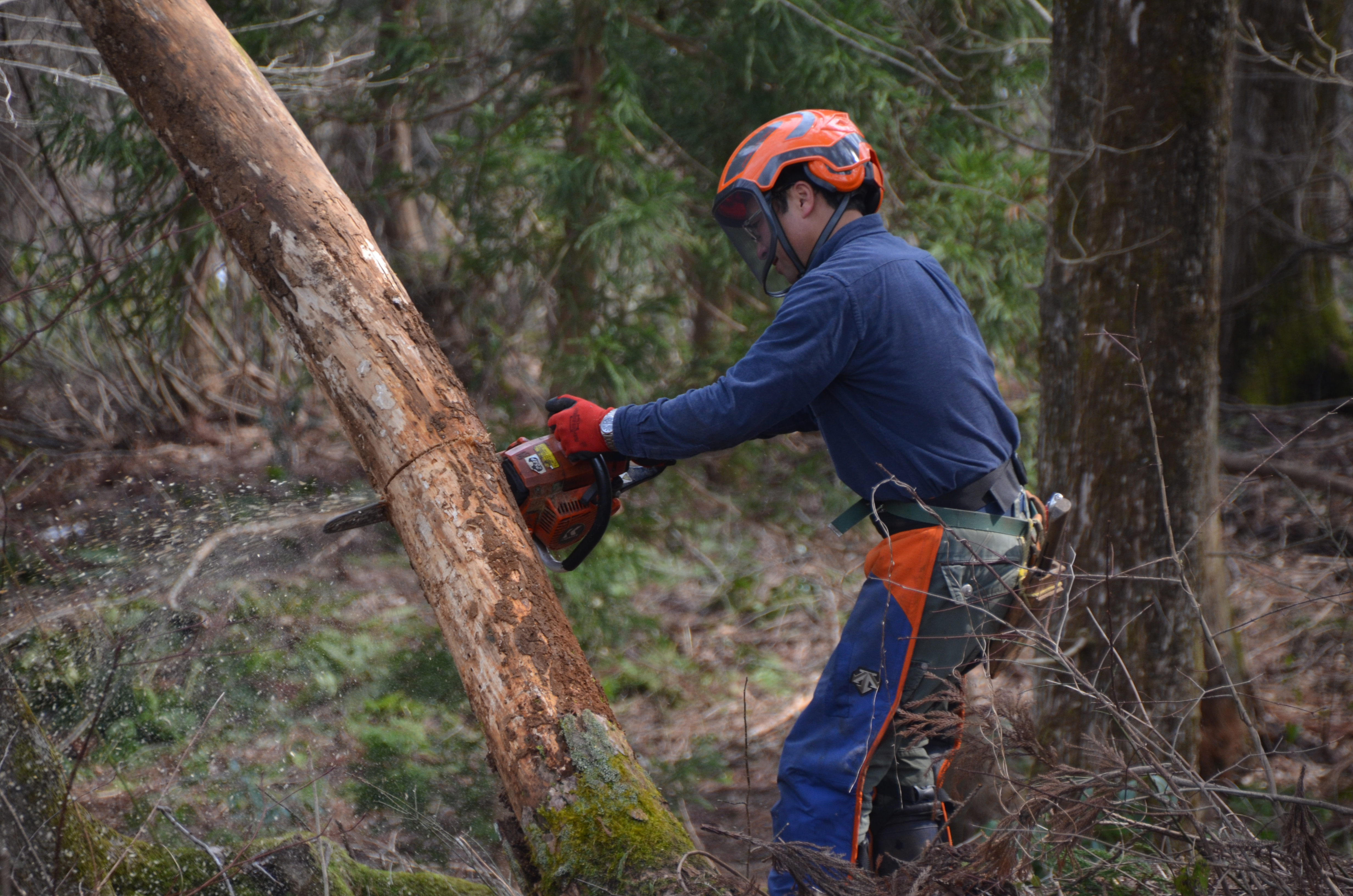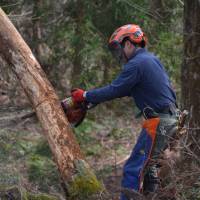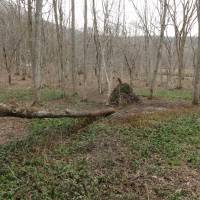As I write this, April is two-thirds gone and the snow around our house and in our woods has almost disappeared, leaving butterburs to sprout up everywhere. Today was quite warm and we heard the first songs of the bush warblers. The Torii River that flows right past my study and gym is swollen and rushing white with meltwater, though there's still plenty of snow on 2,053-meter-high Mount Kurohime.
I didn't make it up the mountain this last winter, but my guess is that the snow on the slopes was 4 to 5 meters deep. We had a lot of snow in our woods, more than we've had for years, but it was hard to measure because it often rained after a snowfall. The snow itself was heavy and wet, quite different from the light and powdery stuff we got when I first came to live in the area in 1980.
This last winter, we've also had more damage to trees than I've seen in the 30 years since I began buying neglected woodland and bringing it back to health in the hills of northern Nagano Prefecture.
The damage didn't actually come as a surprise, because staff members of our Afan Woodland Trust and I made regular sorties on snowshoes into the woods over the winter months and we could see how so many young trees had their upper branches bent over by the weight of snow, and as more and more of it fell they became bent like bows with their top branches firmly embedded.
However, it wasn't until the snow melted that we saw the dozens of big trees that had fallen down, some of them uprooting great wads of earth. I wondered if some of them had been weakened by the plague of hairy caterpillars of the gypsy moth (Lymantria dispar japonicus) — known as maimai ga in Japanese — that stripped so many trees of theirs leaves last May and June.
In the early 1960s when I first came to Japan, I lived in a little place called Akitsu on the outskirts of Higashi-Murayama, a western suburb of Tokyo. It was still a farming community back then, with lots of coppiced woods. Many of the older farmhouses used firewood to heat the bath, so people would go into the woods to gather dry fallen branches.
In the autumn they would also gather fallen leaves, which were used on the fields as fertilizer. The farmers would dig a trenches between rows of growing vegetables, put in a layer of leaves with other compost laid on top, then bury the lot and leave it for the next planting of daikon radish or cabbage or what-have-you.
By that time, Japan had turned to using chemicals on the fields and paddies but, to me, back then the lifestyle seemed very traditional and what many would call "organic" nowadays.
Also, because dead trees and branches were cleared away and the woods were generally well maintained, they were wonderful places for children to explore and play in, and on the weekends you'd always find youngsters romping around in them.
When we first started working with our Afan woodland, my forester used to make huge bonfires of cleared brush and dead wood, while we used trimmed-out tree trunks for firewood, to make charcoal, and to spore for growing shiitake and winter mushrooms — a practice we still continue.
One time though, Canadian biologist friends who'd come to stay with us suggested that rather than burn the brush and dead wood, it would be better to gather it together in scattered piles. This is what we have been doing for the past 20 years, because the piles make superb hiding places for small birds and animals fleeing from hawks, and also provide habitat for snakes, lizards and all kinds of beetles. Then, as the wood slowly decays and the piles collapse, many kinds of mushrooms grow before bacteria complete their work and all the nutrients are returned to the soil.
Fallen tree trunks provide habitat for insects too, especially ants. Bears know this and will rip the old, rotten tree trunks to pieces to get at the ants' nests. Moss will grow on these old trees, often along with flowers like violets, whose seeds the ants carry into their nests because of their sugary coating, which they like.
Tree seedlings will also grow in the same way, which is why you often find straight lines of trees in old forests — seemingly planted by man but actually dropped on old fallen trees that are in time converted to rich, spongy forest soil, helping to conserve water as well as providing succor for young trees. Seeds that fall and grow along the trunk of an old fallen tree also have the added advantage of starting off above the ground; they don't have to compete from the outset with all the other seedlings that fall on the forest floor.
In our woods, unless we need the timber, I always urge that a tree which has fallen naturally should be left to lie where it comes to rest — as long as it's not blocking a trail or isn't hung up in another living tree. Trees that get hung up can not only damage other trees, but they are a potential hazard and are extremely dangerous to cut free. Chain saws are dangerous enough in a simple cutting, but the weight of hung-up trees can easily pinch the blade, and those that are bent have stored up energy in them, like giant bows. If you ever have to do this kind of job, use professional protective equipment!
This spring the woods look like a war zone. Since we became a trust in 2002, we have a lot of visitors and many will look at a fallen tree and think us lazy for not "tidying up." However, if I am on site, or our forester, Yasushi Ishii, we can explain that the Afan woodland is not a park, and that dead wood in a forest has its place and function. That said, this spring there are so many fallen and broken trees that we can't just leave them for the many years it would take for nature to tidy up.
In the past I have been critical of the Forestry Agency's practice of felling trees in national cedar plantations and just leaving them on the ground. I was never against trimming out spindly specimens, but against the waste. To me it looks ugly, too. These fallen trees also pose a danger on steep slopes and valleys where they might be swept along by landslides or flash floods and come down in huge tangled and unmanageable masses.
So as I write this, Mr. Ishii is already out with his chain saw, and I will see to it that he gets help in salvaging really good firewood. I had to attend Earth Day in Tokyo over the weekend of April 18-19, and although I trust our forester, it still worries me that he has to do such a risky job by himself.
The purpose of our woodland is to nurture biodiversity while using wise and often traditional methods to harvest all the gifts we get from it. In addition, we provide a place for education and continuing research, since woodland is always changing and we need to try to understand how and why.
The Afan Trust woods are also a place of healing, so rather than the sight of lots of fallen trees, which makes even me feel sad, we should replace them where we can with healthy saplings — and enjoy all the flowers that spring to life when extra light reaches the forest floor.
When I get back from Tokyo, I'll put on my boots and helmet, grab some working gloves and tools and get to it. Talk about a labor of love!





